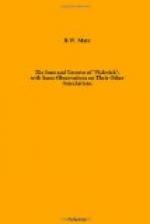“There’s beds here, sir,” Sam assured his master as a further inducement; “everything clean and comfortable. Very good little dinner, sir, they can get ready in half an hour-pair of fowls, sir, and a weal cutlet; French beans, ’taters, tart and tidiness. You’d better stop vere you are, sir, if I might recommend.” At this very moment the host appeared, and, having confirmed Sam’s statement, Mr. Pickwick decided to take the “advice” of his trusted servant, which caused the landlord to smile with delight.
[illustration: The Pomfret Anns (formerly the “Saracen’s Head"), Towcester. Drawn by C.G. Harp]
The pilgrim to Towcester to-day, searching for the sign of the “Saracen’s Head,” would find himself on a fruitless errand, for it was changed scores of years back to the Pomfret Arms. Indeed, it was so called at the time The Pickwick Papers were first published, having been altered in 1881 at the bidding of the new lord of the manor when he succeeded to the titles and estates.
But doubtless Dickens knew it in his newspaper reporting days, and described it from memory. In any case, he is historically correct in retaining the old name, for the period of his book is 1827-28. Beyond the change of name the hotel to-day is practically the same as it was in those early days, the only material alteration being the conversion of the kitchen into a bar-parlour and smoking-room, where the open chimney and corner seats have given place to more modern and ornate substitutes.
Situated in the main street this old posting house is a prominent feature. The exterior is typical of the period. It is a low, long-looking building with many windows, two stories high (unless the dormer windows in the old red-tiled roof be counted another), and is built of a light brownish sandstone brick, peculiar to the neighbourhood. There is a picturesque bow window on the ground floor to the left of the solid oak gateway leading into the coach yard, and over this hangs the swinging sign-board flanked on each side by two curious carved figures set in alcoves let into the wall; the whole general setting is a pleasant survival of the old-time days of the coaching era.
There always is an agreeable and comforting relief to the traveller when he at last arrives at the inn at his journey’s end, and that feeling will not be dispelled to-day when the old “Saracen’s Head” is reached. But to the Pickwickians, on the occasion of their visit, wet to the skin, tired, and sorely out at elbow with the raging element they had just driven through, the “Saracen’s Head” must have been a haven of delight indeed; and those few words of instructions from the landlord to make the room ready for them must have been cheerful to their ears, and the result, as described in the following paragraph, a joy to their hearts:
“The candles were brought, the fire was stirred up, and a fresh log of wood thrown on. In ten minutes’ time a waiter was laying the cloth for dinner, the curtains were drawn, the fire was blazing brightly, and everything looked (as everything always does in all decent English inns) as if the travellers had been expected and their comforts prepared for days beforehand.”




